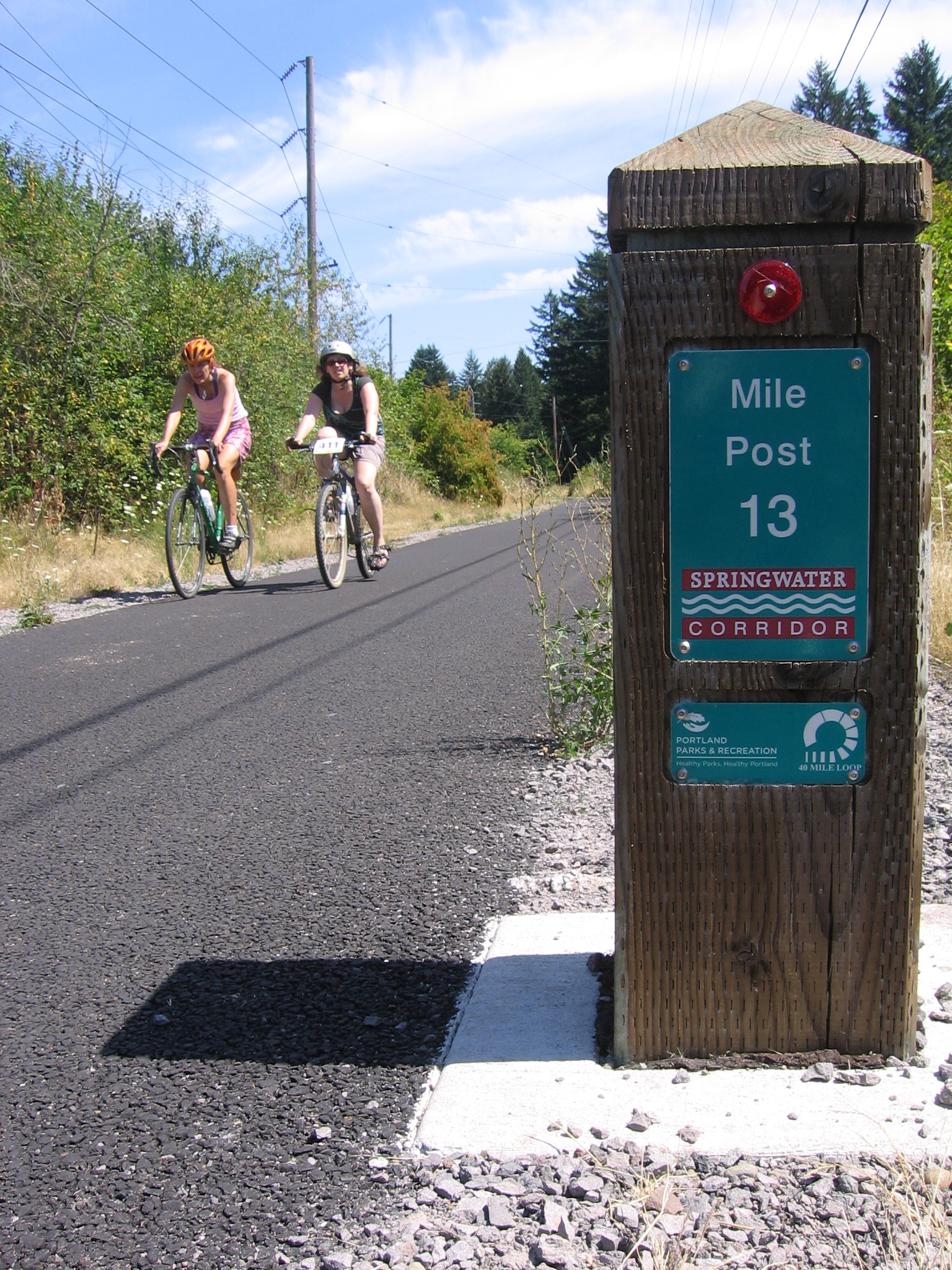The Springwater Corridor is a 21-mile-long recreational trail stretching from the Willamette River through southeast Portland and Gresham to the town of Boring. The trail is built on a former rail line and is popular as a recreational and transportation corridor for pedestrians and bicyclists. In 2008, the trail averaged 2,800 daily bicycle trips at one southeast Portland location.
In 1903, an inter-urban electric railroad, the Springwater Division Line, opened from southeast Portland to Boring and then south to the Cazadero Dam station near Estacada. Plans to extend the line to the town of Springwater led to the route's name. The rail line ceased passenger service in 1958 but continued as a freight line until 1989, when the rights were acquired by the state. The City of Portland acquired the corridor in 1990, and the trail opened to users in 1996.
The trail constitutes a major part of the 1904 Olmsted park plan for Portland. The Olmsted Brothers firm, created by the sons of the famous landscape architect, Frederick Law Olmsted, suggested building a 40-mile ring of greenspace around the city. Although that plan was never formally adopted, it remained part of Portland's civic conversation. In 1981, a group called the 40-mile Loop Land Trust formed to carry out the Olmsted plan's vision.
Future plans include filling in gaps to create a seamless trail and a potential 10.8-mile extension east into the Mount Hood National Forest, possibly to connect with the Pacific Crest Trail system.
-
Springwater Corridor, milepost 13, 2, Aug 21 2011.
Springwater Corridor Trail, milepost 13, Gresham, Aug. 21, 2011. Photo James V. Hillegas
-
Springwater Corridor, wetland, 1 Aug 21 2011.
Wetlands along Springwater Corridor Trail, Gresham, Aug. 21, 2011. Photo James V. Hillegas
-
Springwater Corridor, Linneman Sta Depot, 2, Aug 21 2011.
Linneman Station Depot sign along Springwater Corridor Trail, Gresham, Aug. 21, 2011. Photo James V. Hillegas
-
Springwater Corridor, Portland Century riders, 3 Aug 21 2011.
Portland Century riders along Springwater Corridor Trail, Gresham, Aug. 21, 2011. Photo James V. Hillegas
-
Springwater Corridor, Gresham sign, Aug 21 2011.
Springwater Corridor Trail, Gresham, Aug. 21, 2011. Photo James V. Hillegas
-
Image Title.
Springwater Corridor Trail sign along SE Johnson Creek Blvd., Portland, Aug. 21, 2011. Photo James V. Hillegas
-
Springwater Corridor, along Willamette R, 11, Aug 21 2011.
Springwater Corridor Trail along Willamette River, Portland, Aug. 21, 2011. Photo James V. Hillegas
-
Springwater Corridor, along Willamette R, 2, Aug 21 2011.
Springwater Corridor Trail along Willamette River, Portland, Aug. 21, 2011. Photo James V. Hillegas
-
Springwater Corridor, along Willamette R, 3, Aug 21 2011.
Willamette River seen from Springwater Corridor Trail, Aug. 21, 2011. Photo James V. Hillegas
-
Springwater Corridor, along Willamette R, 5, Aug 21 2011.
Willamette River seen from Springwater Corridor Trail, Aug. 21, 2011. Photo James V. Hillegas
-
Springwater Corridor, Oaks Bottom WR, 2, Aug 21 2011.
Oaks Bottom Wildlife Refuge along Springwater Corridor Trail, Portland, Aug. 21, 2011. Photo James V. Hillegas
-
Springwater Corridor, Oaks Park, 2, Aug 21 2011.
Oaks Park along Springwater Corridor Trail, Portland, Aug. 21, 2011. Photo James V. Hillegas
-
Springwater Corridor, 1st bridge over Johnson Crk, 2, Aug 21 2011.
Springwater Corridor Trail bridge over Johnson Creek, Portland, Aug. 21, 2011. Photo James V. Hillegas
-
Springwater Corridor, Sellwood Bridge, Aug 21 2011.
Springwater Corridor Trail passes under Sellwood Bridge, Portland, Aug. 21, 2011. Photo James V. Hillegas
-
Springwater Corridor, first bridge over Johnson Crk, 3, Aug 21 2011.
Johnson Creek, Portland, along Springwater Corridor Trail, Aug. 21, 2011. Photo James V. Hillegas
-
Springwater Corridor, bridge over Hwy 99E, 2, Aug 21 2011.
Springwater Corridor Trail bridge crossing Hwy 99E, Portland, Aug. 21, 2011. Photo James V. Hillegas
-
Springwater Corridor, bridge over Hwy 99E, 3, Aug 21 2011.
Springwater Corridor Trail bridge crossing Hwy 99E, Portland, Aug. 21, 2011. Photo James V. Hillegas
-
Springwater Corridor, bridge over RR tracks, 1, Aug 21 2011.
Springwater Corridor Trail railroad crossing, Portland, Aug. 21, 2011. Photo James V. Hillegas
-
Springwater Corridor, Johnson Crk watershed sign, Aug 21 2011.
Tideman Johnson City Park, Portland, Springwater Corridor Trail, Aug. 21, 2011. Photo James V. Hillegas
-
Springwater Corridor, 2nd brige over Johnson Crk, Aug 21 2011.
Springwater Corridor Trail, Tideman Johnson City Park, Portland, Aug. 21, 2011. Photo James V. Hillegas
-
Springwater Corridor, MKP svc, 4, May 2011.
Restoring sign along Springwater Corridor trail, May 2011. Photo James V. Hillegas
-
Springwater Corridor, I-205 underpass, Aug 21 2011.
Springwater Corridor Trail, I-205 underpass, Portland, Aug. 21, 2011. Photo James V. Hillegas
-
Springwater Corridor, xing at Foster, Aug 21 2011.
Springwater Corridor Trail, crossing at Foster Boulevard, Portland, Aug. 21, 2011. Photo James V. Hillegas
Map This on the Oregon History WayFinder
The Oregon History Wayfinder is an interactive map that identifies significant places, people, and events in Oregon history.
Further Reading
City of Portland, Springwater Corridor Master Plan. 1992.
Little, Charles E. Greenways for America. Baltimore: John Hopkins University Press, 1990.
http://www.portlandonline.com/shared/cfm/image.cfm?id=217489























